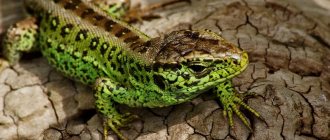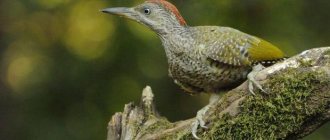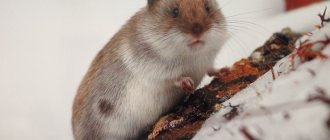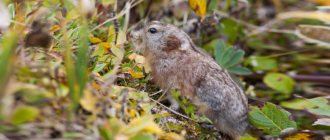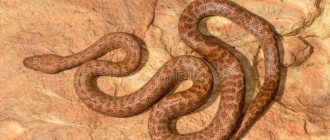The name Mednovsky Arctic fox is associated with Medny Island, located between the Pacific Ocean and the Bering Sea. The Komandorsky Nature Reserve is located throughout its entire area. It is thanks to its creation and existence that a small population of this animal species is preserved. About a hundred blue foxes live on the territory of the reserve.
In years rich in food, during the summer, quite a lot of blue foxes are born, which, due to lack of hunting experience, often fall off cliffs and die. But the main culprit in the decline in the number of these animals is still humans.
Description of the blue Mednovsky fox
— Advertising —
The blue fox is also known as the arctic fox and its appearance is very similar to the well-known red fox. The Arctic fox is a little smaller in size, has a stockier build, and is not as mobile. The body length of the animal ranges from 50 to 75 cm, weight is 2.5-3.5 kg. Males are larger than females according to these indicators. The muzzle is shortened, neat, with rounded short ears, small eyes and nose. The legs are short, which helps the animal reduce heat loss due to less contact of the body surface with cold air. The claws on the paws do not retract, which is a sign of the canine family. The animal's sense of smell, vision and hearing are well developed.
The blue fox's fur is thick and the undercoat is warm. With the help of such a fur coat, the animal is able to live at winter temperatures down to -60-65 °C. Even the pads on the animal’s paws are covered with fur. Molting is typical in spring and autumn. Begins in March and September and lasts about 4 months. The blue fox has a pronounced change in seasonal color. In summer, the fur is short, and the color changes from dirty brown to reddish-gray. In winter, the fur is long, soft, dazzlingly white with a delicate blue tint.
Adaptation to cold
The Arctic fox animal managed to adapt to the cold through several natural improvements. Firstly, this is the structure of the fur. The animal's winter coat is dense and multi-layered, it perfectly retains heat. Secondly, short rounded ears protrude slightly above the fur, this protects them from severe frosts. Thirdly, the shortened muzzle and legs reduce heat loss. Fourthly, even the soles of the paws of Arctic foxes are covered with fur: here it is thick and hard, which prevents the animal from frostbite. Thus, nature took care of the fur-bearing animal, and the arctic fox is guaranteed not to freeze in any cold weather in winter.
By the way, it was the presence of hair on the soles of the paws that gave the species its scientific name (lagopus). This is translated from Greek as “rabbit’s foot.” Therefore, the arctic fox is sometimes called the hare-footed fox.
Feeding characteristics of the Mednovsky blue fox
The blue fox's diet includes mainly rodents (lemmings), seabirds and their chicks.
The animal is inclined to destroy bird nests, eat eggs, willingly eats fish, shellfish, and marine invertebrates, and in times of famine does not disdain carrion. In summer and autumn, it also eats a variety of plants and berries to replenish the supply of vitamins in the body. Blue foxes go hunting only after they are convinced that the area is safe. They rarely go fishing in packs, as they do not hunt large animals. It is difficult for arctic foxes to hunt in winter, when the fields are covered with snow and it is much more difficult to catch a rodent.
— Advertising —
Like other types of predators, blue foxes are excellent at navigating their terrain using their keen sense of smell and hearing.
Keeping at home
For exotic lovers, you can try keeping the Arctic fox at home. It is best to keep the Arctic fox in a spacious wooden cage. If the arctic fox is small, then it is better to keep it not alone, but with its brother. You can feed the Arctic fox with food that is natural to it: meat, fish, cereals. Moreover, if in winter he does not consume a lot of food, then in the summer, when his metabolism accelerates, the arctic fox becomes a real glutton, which is not surprising, because he needs to store fat for the winter.
Distribution of the Mednovsky blue fox
The only place where blue foxes live is Medny Island (Commander Archipelago, between the Bering Sea and the Pacific Ocean). Now the island is the territory of the Commander Nature Reserve, which was created in 1993. It is there, on an area of 186 km2, that the entire known population of these animals lives. Mednovsky Arctic foxes live on the sea coast; there are much fewer of them inside the island. The animals' homes are located among large stones, as well as along rocky cliffs on the seashore.
Popular topics today
- Meteorites
In science, meteorites are bodies of celestial origin that have fallen to the earth's surface. As a rule, before falling on our planet, meteorites are part of larger celestial bodies, meteorites - First trip around the world
Ferdinand Magellan was born in 1480 in Portugal into a poor family of nobles. When the boy was 10 years old, the father managed to place his son in the court of King Juan, where he was brought up and studied for the state. - Morning exercises
Morning exercises are a short set of simple exercises performed immediately after waking up. At night, the human body rests, and during the day, it must be active. - Prince Svyatoslav
In 942, the Kiev prince Igor and his wife Olga had a son, whose name was given Svyatoslav. According to ancient chronicles, this was the only son of Prince Igor, and only he was destined to have a hundred - Desert Plants
The desert is considered a place where there can be no life except sand, but this is a mistaken opinion. In the desert you can find different animals, insects, lizards, which means that in the desert they can grow - Chanterelle mushroom
The common chanterelle mushroom is used as human food. Belongs to the Chanterelle family. He got his name from the Russian word
Male and female blue Mednovsky fox: main differences
Males of the Mednovsky Arctic fox are always larger in size than females, which is the only main manifestation of sexual dimorphism for them. Otherwise, there are no differences in the appearance of representatives of the different sexes of this species.
Place for an arctic fox farm
In the case of Arctic foxes, the same principle applies as for all other fur-bearing animals: the further north the farm is located, the higher quality fur will be obtained from the animals. Of course, the tundra zone is best suited for this, but given that more or less developed communications in this zone are only in some areas, willy-nilly, many entrepreneurs have to open fur farms south of the Arctic Circle. Meanwhile, outside the tundra zone, the quality of arctic fox fur is greatly reduced.
As for the type of terrain, any flat and dry area is suitable, preferably in an elevated place, but protected from the winds. It is optimal if there are a lot of trees and shrubs around the farm, which will not only protect the farm from the winds, but will also create a favorable environmental situation at the site.
Behavior of the Mednovsky blue fox
The most comfortable place for blue foxes to live is in relief areas in the open tundra.
There must be sources of water in this area. The peculiarity of their home is that each hole has several entrances and exits, and complex tunnels branch and reach several meters in length. Due to the fact that in the natural habitats of the species there is not always enough terrain for such a labyrinth, blue foxes use the same burrows for hundreds of years, and pass them on to each other by inheritance. In summer, Mednovsky blue foxes spend almost the entire day searching for food. They live in small family groups of one male and several females along coastlines and beaches where food is always abundant. They usually rest little, either in burrows or in the air. In winter, they lead a nomadic lifestyle, wandering in search of food throughout the island. As a tundra animal, the Mednovsky blue fox usually sleeps right on the snow far from its shelter. During severe frosts and snowstorms, animals retain heat in burrows dug in the snow, in which they remain for several days. They communicate with each other using sounds that resemble barking, squealing and howling.
Cages and houses for arctic foxes
Cages in which animals are kept should be placed at a distance of a meter from each other, and it is advisable to leave at least two meters between rows of cages for ease of maintenance. Rows of cages must certainly be protected from precipitation by a canopy. In addition, the canopy protects the animals' fur from fading under the sun.
The cages themselves for adult animals and growing young animals are made of durable mesh and raised above ground level by half a meter or a meter. The mesh on the walls may be larger, but for the floor, in any case, you should choose one with small cells so that the arctic foxes can walk on them comfortably.
Although arctic foxes live in families in the wild, in a fur farm it is still better to keep them alone. The only obvious exception is females with milk puppies. The minimum dimensions of single cells are 2-6 meters in length, 1-1.5 meters in width and 0.6-1 m in height. To save space on the farm, you can make paired cages with one adjacent wall, which is reinforced with boards. In this case, the doors are made from the opposite side.
In each cage containing an adult Arctic fox, it is necessary to provide a small house that imitates a mink or nest. The dimensions of the house must be at least 60 cm wide and 110 cm long.
Today, if you wish, you can order standard cages according to a ready-made project, without bothering with making them yourself. True, the starting costs for creating a fur farm will increase noticeably.
Reproduction of the Mednovsky blue fox
The breeding season for the Mednovsky blue fox begins in March-April. In June, from 3 to 5 weak and vulnerable cubs are born. During this period, the parents remain in a permanent territory, which they guard from enemies. The female spends all the time next to the babies, in the burrow, and feeds them with milk for the first two weeks of their life. Other members of the group (a male and 2-3 young females) bring her food. At the age of 3 weeks, blue fox puppies leave the norm, but adults continue to closely monitor them. During this same period, babies receive meat complementary foods for the first time. After 3-4 weeks, they leave the family shelter and begin to live independently, after which the group breaks up. Due to the limited territory of the island, during resettlement, approximately a quarter of young individuals die in competition with adult Arctic foxes.
Hunting
The Arctic fox goes hunting only after it is completely convinced that the environment is safe for itself. They almost never travel in packs when fishing, since large animals are not hunted. It is more difficult for the animals in the cold season, when the fields are covered with snow and catching rodents becomes somewhat more difficult.
Like other types of predators, the arctic fox is excellent at navigating the terrain with the help of a heightened sense of smell and hearing. When necessary, it makes sounds that are almost identical to the bark of a domestic dog puppy.
At the moment, it is very difficult, if not impossible, to meet this animal in the wild. However, it is bred quite often in captivity, but only for industrial purposes. No matter how cruel it may sound, most people are only interested in the Arctic fox for its beautiful fur. At one time, it was precisely this interest that led to the fact that the species was listed in the Red Book and is strictly protected.
Source: ECOportal.info
Arctic fox Vulpes (Alopex) lagopus Linnaeus, 1758
Subspecies V. l. beringensis Merriam, 1902, V. l. semenovi Ognev, 1931
Island Arctic fox, Medny Island. The author of the photo is Evgeny Mamaev.
The body length of male Bering Arctic foxes is 46-67 cm (average 60 cm), and weight is 3.5-8.8 kg (average 5.5 kg); in females, body length is 41-64 cm (average 57 cm) and weight - 2.5-6.4 kg (average 4.4 kg). The body length of male Mednovsky Arctic foxes is 61-73 cm (average 68 cm), and weight - 4-8.8 kg (average 7.2 kg); in females, body length is 60-68 cm (average 64 cm), and weight is 4-7.2 kg (average 6 kg). Newborn puppies have a body length of up to 13 cm and weigh up to 85 grams.
The Arctic fox is a species of predatory mammals distributed circumpolarly. The Arctic fox subspecies V. l. lives on the Russian mainland. lagopus L., which is distinguished by its white fur color in winter. On the Commander Islands, the arctic fox is represented by an island form, the so-called “blue” arctic fox. The fur color of the island subspecies is smoky grayish-brown all year round, with slight variations in shades in different seasons. The subspecies V. l. lives on Bering Island. beringensis Merriam, 1902, and on Medny Island – V. l. semenovi Ognev, 1931. S. I. Ognev in 1931, describing a new subspecies of arctic fox from Medny Island, assigned it the Latin name semenovi in honor of the famous researcher A. P. Semenov-Tyan-Shansky. In addition to the two Commander subspecies in the Bering Sea basin, experts distinguish two more subspecies of island foxes: V. l. pribilofensis Merr., 1902, which lives on the Pribilof Islands, and V. l. halensis Merr., 1900, found on Hall, St. Matthew and St. Lawrence Islands.
Island subspecies of Arctic fox in the Bering Sea and places of their acclimatization.
It is believed that the Arctic fox appeared on the Commander Islands approximately 80 thousand years ago, and about 12 thousand years ago the final separation of the two subspecies occurred (the connection between the Arctic fox populations on Bering Island and Medny Island ceased). The arctic fox could enter the islands during periods of cold weather through the ice.
Molting Arctic fox in spring. The author of the photo is Evgeny Mamaev.
The Arctic fox's rut on the Commander Islands occurs in February-March (the deadline is from late January to early May). Pregnancy - 49-56 days. Puppies are born in May-June (cases of puppies being born have been noted in mid-April and July). About 9-13 days after birth, puppies' eyes open. 3-4 weeks after birth, the puppies begin to emerge from the hole (late June). The duration of lactation is 1.5-2 months, but already at the age of one month, puppies begin to eat meat food that their parents bring to them. Broods begin to break up in late August and early September. Sexual maturity occurs at 10 months. Life expectancy is up to 10 years (on the Commander Islands life expectancy is up to 7 years). A female on the Commander Islands can have 10-13 puppies in her litter (4-6 on average).
Mother of a large arctic fox family. The author of the photo is Evgeny Mamaev.
Arctic fox puppy. The author of the photo is Evgeny Mamaev.
Unlike their mainland counterparts, who live in pairs, arctic foxes on the Commander Islands form complex families. Thus, in complex families of arctic foxes on Medny Island there can be from 3 to 6 adult animals. Among them there may be not only helper females, who are the offspring of this pair from the previous year, but also breeding females who live on the male’s territory in other burrows. In general, there may be up to 60% of such complex families in the population. While the pups do not leave the hole, the males provide the female with food. If a male has several females with puppies, he takes turns carrying prey into each of these holes. As soon as the pups begin to leave the hole, both parents go after the prey, and the female goes more often during this period.
A pair of playing Arctic foxes. The author of the photo is Evgeny Mamaev.
Breeding of offspring in Arctic foxes occurs in burrows, which can be very branched. The depth of Arctic fox burrows on the islands is no more than 1 m. The burrows have several holes. On the Commander Islands, burrows with 40 nests were noted. In this case, the burrow has main passages up to 4 m long, from which branches up to 1.5 m long extend. The diameter of the entrance hole is from 15 to 30 cm. The main nesting chamber is up to 60 cm wide and up to 50 cm high. Inside it is covered with dry grass.
In some cases, Arctic foxes can use one hole for 20 years, and in some places for 1-2 years, and then leave the hole and live in another. After some time, the hole is repopulated by a new pair, and this is how a rotation of residential and non-residential holes occurs. Researchers do not find completely new burrows on the islands, but arctic foxes use existing ones.
In winter, to protect themselves from snowstorms, Arctic foxes make snow holes, digging them in snow drifts. The length of such burrows is up to 1-1.5 m. The snow burrows end in a chamber 40 cm wide and up to 25 cm high.
In winter, Arctic foxes regularly explore the coast in search of food. The author of the photo is Evgeny Mamaev.
After the breakup of the broods, the Arctic foxes disperse throughout the island. In this case, males can settle up to 5 km from the parent site, and females - 2 km. At the same time, over 50% of female Arctic foxes on Medny Island remain on or near their parental site, that is, they practically do not disperse.
Arctic fox tracks in the snow. The author of the photo is Evgeny Mamaev.
The Arctic fox is an omnivorous predator. Over 70 different types of food were found in the diet of the Commander Arctic fox. In summer, the Arctic fox's diet consists of birds and fish. The arctic fox finds a lot of food in the rookeries of marine mammals. Moreover, on Bering Island, which has a well-developed river network, arctic foxes eat a lot of fish, and only in the southern mountainous part of the island do birds form the basis of their diet. On Medny Island, the Arctic fox's diet in summer consists of seabirds. In the winter period of the year, when seabirds leave the islands, the arctic fox begins to consume to a greater extent a variety of marine invertebrates thrown ashore by the sea.
On Bering Island, during the salmon spawning season, arctic foxes actively consume them as food. The author of the photo is Evgeny Mamaev.
An abundant source of food for arctic foxes on the Commander Islands are the rookeries of marine mammals. At the same time, in rookeries, arctic foxes feed not only on dead animals, but can also kill living northern fur seal pups. This has been repeatedly observed by many researchers at all commander’s rookeries. In winter, during the most difficult period of their lives, arctic foxes actively eat the corpses of marine mammals. Most often these are dead sea otters, which live in the coastal areas of the islands all year round. Dozens of Arctic foxes gather at the discarded corpses of whales. Once they counted up to 120 Arctic foxes near one whale corpse. Arctic foxes are not averse to feeding on the corpses of their relatives.
In winter, sea otter carcasses are a significant addition to the Arctic fox's diet. The author of the photo is Evgeny Mamaev.
Discarded whale carcasses are an important source of food for Arctic foxes in winter on the Commander Islands. The author of the photo is Evgeny Mamaev.
In the midst of winter, when there is a catastrophic shortage of food, arctic foxes, in order to survive, can eat their brothers who have not survived the hunger strike. The author of the photo is Evgeny Mamaev.
In the spring, arctic foxes in the littoral zone begin to actively catch frogfish - the naked roundfin Aptocyclus ventricosus (Pallas, 1769), which during this period of the year approaches the shores and lays eggs in the littoral zone. At the same time, the females, having laid their eggs, go back into the depths, and the males remain to guard the clutch. Arctic foxes take advantage of this feature of fish biology. In the spring, Arctic foxes can often be seen on the vast tidal reef slabs scurrying between pools in search of food.
An arctic fox catching a frog fish in the littoral zone. The author of the photo is Evgeny Mamaev.
The Arctic fox swims well. Thus, we observed arctic foxes swimming from reef to reef, examining the breeding grounds of sea otters and northern fur seals in the winter. The swimming speed of the arctic fox is 2-2.5 km/h.
In search of food, Arctic foxes can travel from 30 to 90 km per day. In normal life, as recent studies on the islands have shown, arctic foxes walk an average of about 11 km per day.
The Arctic fox is active throughout the day, but there are peaks of morning activity (from 2 am to 6 am) and evening activity (from 5 pm to 10 pm).
Arctic fox in moments of rest. The author of the photo is Alexey Chetvergov.
The Arctic fox was first discovered on Bering Island by members of Vitus Bering's expedition in November 1741. The first notes on its appearance and behavioral characteristics were made by the expedition's naturalist, Georg Wilhelm Steller. He noted their large numbers and absolute fearlessness towards humans.
The Arctic fox, along with the sea otter and northern fur seal, has been subject to intensive commercial exploitation on the islands. At most, up to 2.5 thousand Arctic foxes were caught in one fishing season on the Commander Islands (in the 90s of the 19th century). At the end of the 19th century, in order to reduce the pressure on the island populations of arctic foxes and not destroy them completely, they began to introduce hunts, when hunting was carried out once every two years. The Arctic fox, thanks to its fertility, unpretentiousness to living conditions and fairly stable and abundant food conditions, quickly restored its numbers. Since the 20s of the last century, arctic foxes began to be actively fed to increase their numbers. In the 30s, the era of island fur farming began on the Commander Islands, which lasted until the mid-60s. Feeding was carried out in specially built feeder traps on the islands (their skeletons can still be seen in some places).
The Mednovsky Arctic fox has always been considered the most valuable during the period of fur farming. At one time, the question was even raised about the need for the complete destruction of the Bering Arctic fox and the introduction of the Mednovsky Arctic fox to Bering Island in order to improve the quality of fur. After the organization of a fur farm on Bering Island in the early 50s, Norwegian veiled arctic foxes began to escape from it, which hybridized with the wild Bering subspecies. Traces of this hybridization are still visible today. In the 60s, it even got to the point where there were proposals to destroy the Mednovsky subspecies and replace it with fur breeding breeds.
Among the wild Arctic foxes of Bering Island you can find individuals with the characteristic Norwegian veil coloration. The author of the photo is Evgeny Mamaev.
Animals from the Commander Islands were actively used for acclimatization on other islands (see diagram above). So, back in 1750, Russian industrialists brought arctic foxes from Bering Island to Attu Island. Subsequently, arctic foxes were brought to a number of other islands of the Aleutian Arc.
While the Bering Arctic fox was used for acclimatization on the islands of the Aleutian arc, the Mednovsky arctic fox was acclimatized on the islands of the Kuril arc, the Shantar Islands, etc.
In 1916 and 1917 Arctic foxes from Medny Island were brought to the islands of Ushishir and Matua (Kuril Islands), and in the 20-30s of the 20th century. They settled even further south - on the island of Simushir and the islands of the Lesser Kuril Ridge. In the 1920s, arctic foxes from Medny Island were brought to the Shantar Islands several times. In 1927-1929, arctic foxes from Bering Island were acclimatized on Toporkov Island, but after they almost destroyed the unique colony of seabirds, this experiment was stopped. In general, in the first half of the 20th century. From several dozen to more than 700 animals per year were exported from the Commander Islands for resettlement to various parts of the country. All this work was carried out as part of the development of island fur farming, in an attempt to populate various territories with valuable blue foxes.
Mednovsky arctic fox at the “warm-up”. The author of the photo is Evgeny Mamaev.
Due to the end of year-round systematic feeding of the Arctic fox on Medny Island in the 50-60s of the 20th century and the defeat of the Arctic fox population by the ear mite Otodectes cynotis in the 70-80s of the 20th century, its number decreased from several hundred to several dozen adult individuals. In addition to tick infestation, artificial selection played a major role in weakening the population, which probably led to a decrease in the genetic diversity of the population and, as a consequence, to a decrease in its resistance to diseases. The Mednovskaya Arctic fox population went through the so-called “bottleneck” and now has extremely low genetic variability. Her future is of great concern, since under certain adverse influences she may die completely. At the same time, the population size of the Mednovsky subspecies is now close to its size in the 20s of the 20th century before the start of artificial feeding and, probably, almost completely corresponds to the modern feeding capacity of the land.
Due to its small numbers, the Mednovsky subspecies of the Arctic fox is included in the Red Book of Russia.
Currently, the number of adult Arctic foxes on Bering Island is estimated at 400-500 individuals, and on Medny Island – 100-120.
A look with hope for the future. The author of the photo is Evgeny Mamaev.
Source: www.komandorsky.ru
Natural enemies of the blue Mednovsky fox
Mednovsky blue foxes are listed in the Red Book of Russia as a species of the first category of protection. The skins and winter fur of this animal are very beautiful and highly valued. Warm fur coats, hats, and collars were very popular among the rich, which caused a sharp decline in the population of the species due to hunting. Now about a hundred of these hardy and beautiful animals live on Medny Island; they are endangered.
Video
And in conclusion, a documentary about our today's hero, the Arctic fox.
Author: Pavel Chaika, editor-in-chief of Poznavaika magazine
When writing the article, I tried to make it as interesting, useful and high-quality as possible. I would be grateful for any feedback and constructive criticism in the form of comments on the article. You can also write your wish/question/suggestion to my email [email protected] or Facebook, with respect, the author.
Author page
Interesting facts about the Mednovsky blue fox:
- Today they are trying to breed the Mednovsky blue fox in captivity. It is very difficult to meet an animal in nature. It was the shooting of animals by people that brought the population of the species to this state.
- Despite the fact that the subspecies for this species of animal are not known, sometimes there is confusion in its name. According to some sources, the term “blue arctic fox” refers to animals that are dark in color all year round. And others also include arctic foxes, whose summer fur is dark, and their winter fur is light, almost white.
- The sounds that the Mednovsky blue fox makes are very similar to the barking of domestic dog puppies.
Where does it live?
The only group of Mednovsky Arctic foxes lives on the Commander Islands, near the Berengov Sea. The habitat of the subspecies is 187 km2. At the moment, there are about a hundred individuals of the subspecies left. The brown arctic fox inhabits the island. Bering. The Icelandic subspecies is found only in Iceland. The white subspecies is the most common and inhabits the entire North Pole. The white arctic fox can be found in the tundra, Scandinavia, Siberia and northern Europe.
